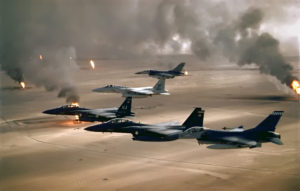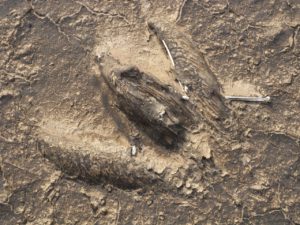The first Gulf War lasted for just a few weeks in early 1991, as American military forces overwhelmed Iraqi troops that had invaded Kuwait. But, as the Iraq army was driven out of Kuwait, they committed unforgivable large-scale environmental sabotage—they set the Kuwaiti oil fields on fire.
Beginning on January 22, 1991, retreating Iraqi forces set oil wells on fire in Kuwait. By the time they were done, more than 700 oil wells were ablaze, burning an estimated 6 million barrels (250 million gallons) of oil per day—more than 40 billion gallons of oil were released in total. A few days later, on January 25, Iraqi forces also sabotaged Kuwait’s coastal oil facilities, causing the release of 8 million barrels (336 million gallons) into the Persian Gulf.

Stopping the fire was a Herculean effort. Not only did the retreating army start the fires, they also placed land mines around many wells, assuring long delays before firefighters could approach the fires. Most of the fires were put out in an ingenious way—repairing the oil pipelines that went from the wells to the sea and then pumping water in reverse to the wells so that it could be used to douse the fires. Other fires were put out by regular oil firefighting companies, like that of the famous Red Adair. The last fires were extinguished in November, 1991, ten months after the conflagration began.
And a conflagration it was. The entire region was engulfed in black smoke. Average temperatures fell by 10 degrees Centigrade because sunlight could not penetrate the smoke cloud. “Black rain” fell for months, as far away as Turkey, Syria and Afghanistan. An estimated 5% of the land surface of Kuwait was covered by thick deposits of oil and soot, forming an asphalt-like layer (termed “tarcrete”) which remains today. More than 200 oil lakes accumulated spilled oil, some as deep as six feet. In the Persian Gulf itself, sea birds perished in the thousands, oil coated miles of seashore, and oil slicks developed that were many miles in area. Humans immediately experienced respiratory distress, and cases of oil-related cancer continued to develop in succeeding years.

A U.S. diplomatic staff member described flying over the site:
“As we approached the fields, even through the thick smoke, you could see the huge tongues of fires burning out of the wells. The starkness of that image became even clearer as we flew between clouds and could see the ground clearly. It looked like the earth had opened up and volcanoes had sprung up everywhere. It was incredible; I have never seen nor hope to see again such horror.”
The cost of the environmental cleanup has been estimated at $40 billion. Time Magazine in 2010 rated the Kuwati oil fires as the third worst environmental disaster in history (exceeded only by Chernobyl and Bhopal).
References:
Association for Diplomatic Studies and Training. Towering Infernos – The Kuwait Oil Fires. Available at: http://adst.org/2016/04/towering-infernos-the-kuwait-oil-fires/#.WmZZtqinFRY. Accessed January 22, 2018.
Chilcote, Ryan. 2003. Kuwait still recovering from Gulf War fires. CNN world. Available at: http://www.cnn.com/2003/WORLD/meast/01/03/sproject.irq.kuwait.oil.fires/. Accessed January 22, 2018.
Counterspill. Gulf War Oil Disaster. Available at: http://www.counterspill.org/disaster/gulf-war-oil-disaster. Accessed January 23, 2018.
McLaren, Duncan, and Ian Willmore. 2003. The environmental damage of war in Iraq. The Guardian, 18 Jan 2003. Available at: https://www.theguardian.com/world/2003/jan/19/iraq5. Accessed January 22, 2018.
PBS. Gulf War Curriculum Guide. PBS, Beyond Broadcast Curriculum Guide. Available at: https://www.pbs.org/wgbh/pages/frontline/teach/gulfguide/gwtimeline.html. Accessed January 22, 2018.
